Halloween the Curse of Michael Myers Is Bad and Funny 1990s
In pursuit of a career in film and upon his arrival to Los Angeles, California in 1987, screenwriter Daniel Farrands' journey to theHalloween franchise, and to being attached to write 1995'sHalloween: The Curse of Michael Myers, would have many a twist and plough. Simply the long-time horror fan was adamantly determined (you lot can read about his early years in part one of our interview series hither), no more then than when in 1989, following an opening dark screening ofHalloween: The Revenge of Michael Myers in Studio Metropolis, California, he stepped out of the darkened theatre to proclaim to his friends,"I'm going to write Halloween six!"
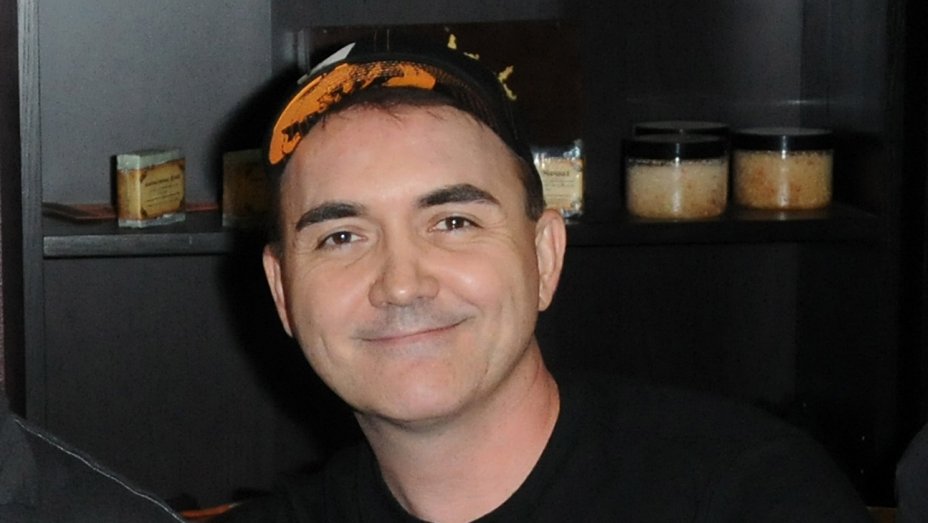
"It was a declaration," Farrands recalled,"and in that location was no other pick. For me writing Halloween six was going to happen. At least I hoped!"
Having made the move from the northern California enclave of Santa Rosa to LA ii years prior, Farrands had spent a semester and change attending CSUN higher in Northridge, before he decided that he no longer wanted to be in schoolhouse.
"So, I got a day job as an assistant at the Motion Pictures Association of America, the place which hates horror movies more than anyone," said Farrands of the ratings board where he worked, the 1 famously responsible for many a requested cut to horror films (and otherwise) ever since its creation in 1922 (every bit the Motion Picture Producers and Distributors of America).
"In those days, it was John Carpenter and Wes Craven and David Cronenberg versus the MPAA, because the MPAA was the enemy, the infamous censor of the time," Farrands recalled."And there I was, this wannabe horror writer and filmmaker working for them. But here's the funny matter, I became friends with all of those people on the board, who remain anonymous to the public. And it got to the point that when they had a horror moving-picture show they were to review, they'd call my extension, because they knew that I was a horror fan. Like, 'Dan, we've got Fri the 13th Part Vii: The New Claret. Come downward to the screening room.' So. I'd go to sit in the projection berth at the MPAA, watching all of these uncut, gore-laden 1980s slasher films in 35mm, versions which sadly would never be seen again."
THE Route TO HALLOWEEN
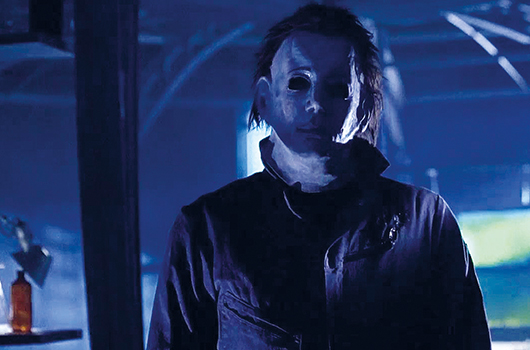
"So afterwards having seen Halloween 5," recalled Farrands of his introduction to a rights holders of theHalloween franchise, which took place in early on 1990, "I embarked on my journey to meet (Halloween serial producer) Moustapha Akkad, who I didn't know at all. Just this was before the internet. In those days, there was this thing chosen the Hollywood Creative Directory. Information technology was like a little guide you could buy at a news stand for 5 bucks, and it would list all of the agile product companies, and in information technology was a listing for Galaxy International, which was a distribution company and so owned by Mr. Akkad. So, I institute the list, and I contacted Ramsey Thomas, (producer of Halloween five) saying, 'Listen, I accept a horror script that I would love to ship you.' Listen y'all, it wasn't a Halloween script. It was an unrelated slasher script, which I don't even remember the name of. But in a thing of days, Ramsay chosen me on the telephone and said, 'Send your script over right away and we'll review it, considering we're making Halloween 6, and we're looking at (potential) writers.' And I was like, 'Wow! So, my plan is coming true! This could really happen!'"
"And so," connected Farrands,"I sent him the script, and Ramsey called me back a couple of days after, and said, 'This script is neat, and yous have I remember what nosotros're looking for, so I want you to come in and pitch an idea for Halloween 6 to Moustapha. Do yous know who that is?' And I said, 'Yes, I know who that is. Are you serious? You want me to come run into this man?' And he said, 'Yeah. Here'due south our address on Dusk Boulevard at Doheny above the Hamburger Village.' I think I had a week in order to prep the pitch."
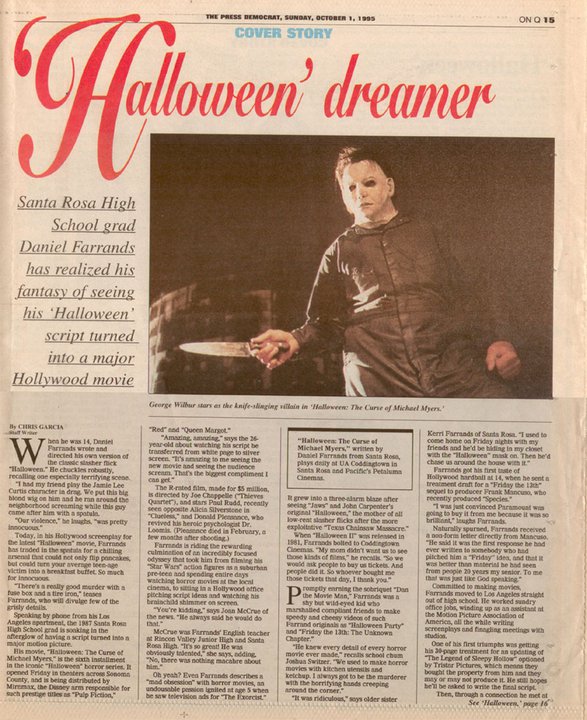
"The Bodhi Tree was this occult bookstore in West Hollywood, which I visited in an attempt to figure out what the fuck that tattoo (seen on the wrist of Halloween 5's duster-and-cowboy-kicking wearing Mysterious Stranger) was, and as well who this character really was,"recalled Farrands of his attempt at making some narrative sense ofHalloween 5 managing director Dominique Othenin-Girard's misreckoning additions to the franchise."And since Halloween 5 wasn't yet on video, I had to draw the tattoo on a slice of paper from retentiveness, and brought it to the clerk at The Bodie Tree, and asked her what the symbol meant. She told me that it was a rune. And she pointed me to a volume called Rune Magic. In it, it had the Thorn (Thurisaz) symbol from the motion picture, and the book explained that it represented an evil giant, and that if the symbol was applied to someone, so they would be visited past the devil. So, I bought a copy of the volume, and decided that I needed to solve this."
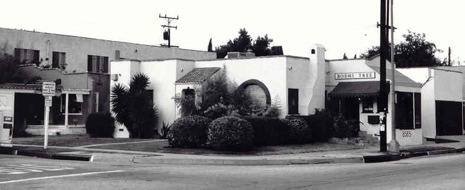
Having never actually pitched a movie before, Farrands recalled,"I thought, 'Permit me go in with the largest amount of stuff I tin can come upwards with.' I already knew so much about all of the Halloween movies and their timelines, which I kind of wrote out similar a gigantic family tree. And I made graphics and I took pages from all the inquiry I'd done on Halloween lore, and annihilation that had to do with the vacation and the mysticism surrounding it. I thought, 'I'll inundate them with that, and as well kind of give them a management which I think the series might go.' Also, I think I wrote out iv or 5 ideas, paragraphs with suggestions of things that we could focus on, while still keeping other options open. So, I wrote that up and put it all in a binder, and my friend created this graphic for the cover that read 'Halloween 666,' but I came upward with another thought. I said, 'We've got to make the 'A' in Halloween the Thorn symbol.' And then, we did, and when information technology came time for the coming together I arrived with the binder, and Ramsey marched me into Moustapha's office. And there he was."
"I can see Moustapha in my memory only like he's there now, and I wish he was," recalled Farrand of Akkad, whose life was taken tragically in a bombing in Jordan on November 11, 2005."Sitting behind that big desk-bound with his pipe in his rima oris, and kind of leaning back in his big chair talking around his pipage. It for me literally felt like I was stepping into the principal's office. My heart was racing. Only, I kind of just started laying out my take on Halloween 6. I don't fifty-fifty know what I said in that meeting. I'm not kidding. It lasted mayhap five minutes. I was in and out. And I left the folder with him, saying something like, 'Well, this is my take on everything that'due south come up before and what I think you could practise going forrad.' I too recall that I said something to him that fabricated him express joy, because information technology came off as naïve and stupid. I honestly don't remember exactly what information technology was I said, but it was one of those moments which you play over and over in your head, knowing how stupid you must have sounded. Open mouth, insert foot time! And I thought, 'Well, that's the end of that. That'due south never going to happen.'"
Active development on a sixth film in the Halloween franchise was before long paused, as legal battles pertaining to the ownership of the sequel rights took place during the early 1990s, and information technology was during this time that Farrands sold a couple of original scripts, which happily immune him to reduce his working hours at the MPAA. It was also during this time that the Northridge earthquake struck southern California, which forced the MPAA to move their offices to the Columbia building in Burbank (as their previous space in Encino had collapsed during the tremblor).
Farrands recalled of his windowless function,"It was horrible, feeling chained to that desk. And then i day, my brother, who lived with at the fourth dimension, calls me at the office and says, 'I just got a message for you lot, from Moustapha Akkad. He called the house looking for yous.' And I was like, 'C'mon! Are y'all certain?' And my brother said, 'I'm one hundred percent certain that it was him. He left his number and he wants you to telephone call him.'"
"This was also around the fourth dimension that Halloween six had already been in the trades. Headlines screaming, 'Miramax Buys Rights to Halloween.' 'Miramax Hires Writer.' Etc., etc. So, I thought at the time that it was over for me. But I called the number anyway, and I was transferred to Moustapha who said, "Daniel, it'due south Moustapha Akkad, and I desire to talk to y'all about Halloween six. I need you to come to my office."
"Then, I did,"said Farrands. "At that time Trancas had their offices in Century City, and when I arrived , Moustapha was once again behind his giant desk with his piping in his mouth, and producer Paul Freeman (producer of Halloween four) was on one side of him, and Moustapha's son Malek, who I'd kept in contact with since my initial meeting with Moustapha, on the other. And there was a chair for me. And they then proceeded to tell me that they'd been through many iterations of the script for Halloween half dozen, and that they had a crew, a mask, and a looming start date to shoot the pic in Salt Lake Urban center, Utah. And they basically said, 'Requite us something skillful, and you'll be hired (to write information technology).'"
"Ane of the directives Moustapha had given me though was, 'Practice not tell me about Jamie Lee Curtis. She's a big star, and she will never brand some other Halloween movie again.' Oh, how I wish he was around now for me to hold that over him, because of course at the time I would have loved to pitch a film thought with Laurie Strode at the heart of it!"
"Anyway, I started pitching them vague ideas I had for Halloween 6. And 1 of the first things that came out of my mouth was, 'Jamie Lloyd.' And they said, 'No,' we can't accept her in this movie, nosotros need to move on from that.' And I said, 'But what if she is the bridge that brings us into the new story, and she'll pass the torch?' So, I started pitching this idea, and the first thing that came spontaneously out of my mouth was, "What if it's like Rosemary'due south Baby meets Halloween?' And Moustapha's eyes bugged out."
"He understood the union of the supernatural to the slasher, just his large question was, 'But who is in the homo in black? Dominique saddled united states of america with this affair from Halloween 5, and not one who fabricated 5 had whatever idea who this mystery man was supposed to be , or what to do with it. So, go! Tell us who he is.' And it'south funny because Malek was in the room and kind of helped me along, kind of rooting for me, and leading me, and he said, 'What if it'due south somebody at Smith'due south Grove?' And I said, 'Yeah, information technology could be Dr. Wynn,' the infirmary administrator seen walking with Loomis in a curt scene in the original movie. and they liked that, and information technology gained momentum, and Moustapha said, "Yous've got a week to write a treatment, and if we like information technology, we'll engage you to write the script.' And that was the first meeting."
"Let me tell you, I didn't sleep at all that week," Farrands remembered."So, I started writing pages. Interestingly enough, Ramsey Thomas, who had introduced me to Moustapha, was no longer with the company, but as I felt indebted to Ramsey, so I'd share pages with him via fax, and he coached me a bit. And the first thing he said was, 'The graphic symbol of the radio guy you created is groovy, and how he connects all of these characters to unlike parts of the boondocks and the story. Do that!' So, that was the starting time of it all, and possibly ten days later I had a dumbo, 20-page treatment, which I sent to Moustapha, and while he said that he really liked it, he felt that it was also large in scope for ane film. But what he did say was, 'What I honey near this, is that (in narrative) nosotros now take the adjacent film ready to go.'"
And so, what was in that original treatment forHalloween half-dozen?
"There was kind of a big reveal at the stop," offered Farrands,"in that all of the people of Haddonfield, in sort of a The Wicker Man/Shirley Jackson's The Lottery sort of way, were all part of this secret society, and that their Halloween tradition was that of offering up a sacrifice for the community's safety. It all played out in a kind of epic third human activity, where Laurie Strode showed in lodge to save her daughter, Jamie. I simply kind of threw Laurie in there at the finish, considering I thought, "maybe we could get Jamie Lee on screen for v minutes!" Subsequently that idea quickly melted abroad, it was off to races , and the reset went really, actually fast."
–
Writer'south annotation: this interview has been lightly edited and condensed for clarity.
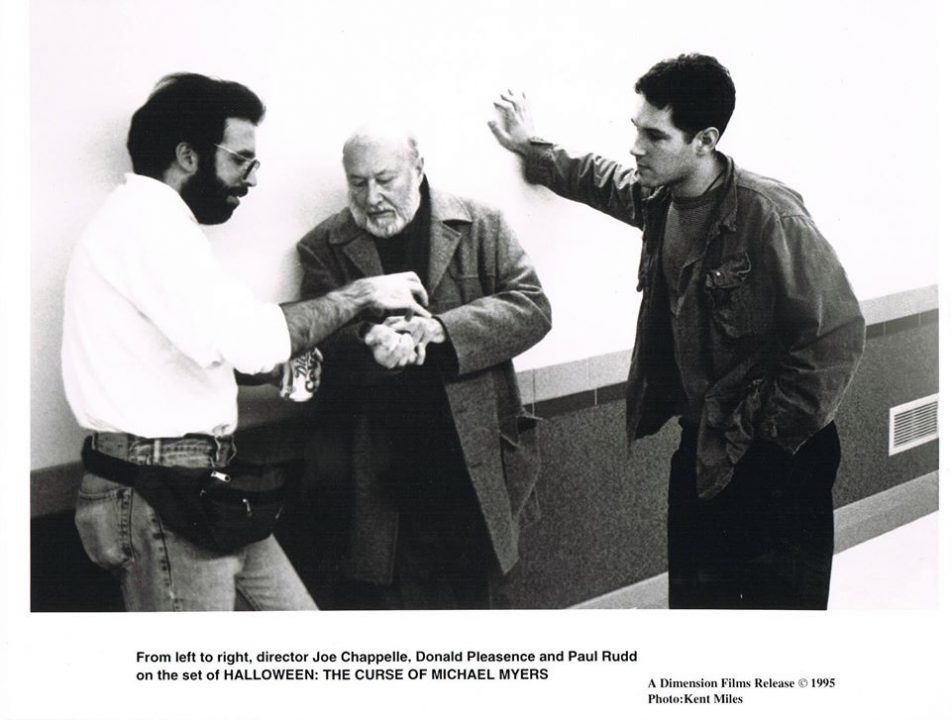
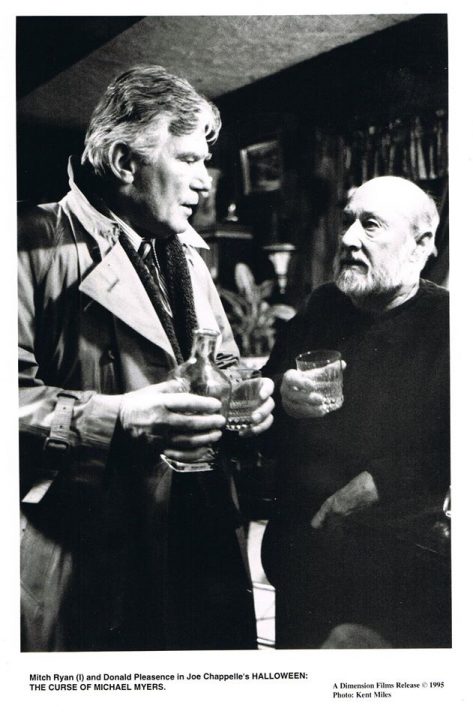
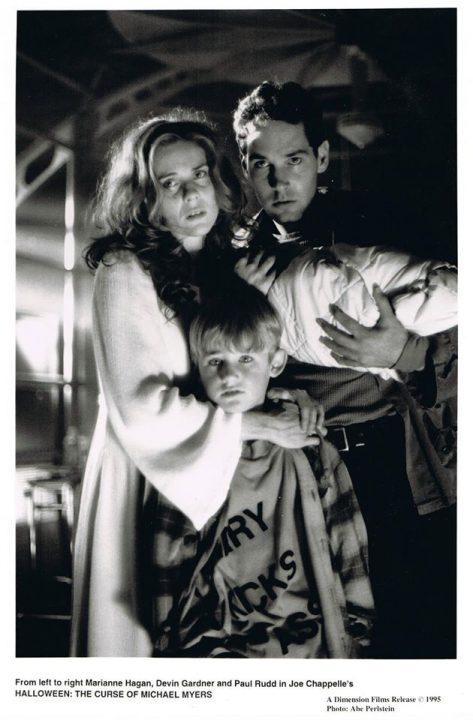
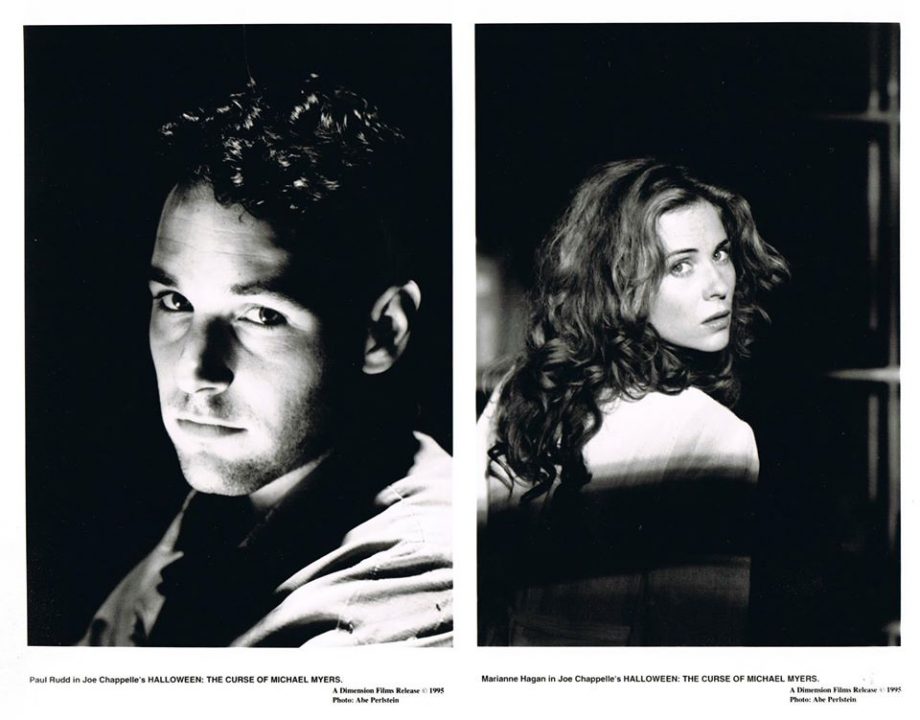
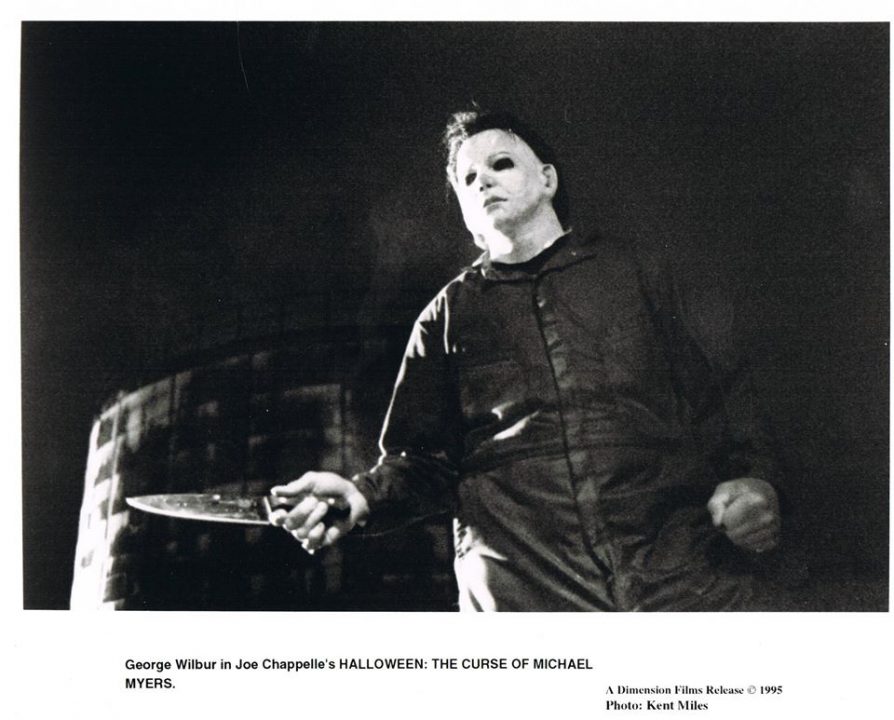
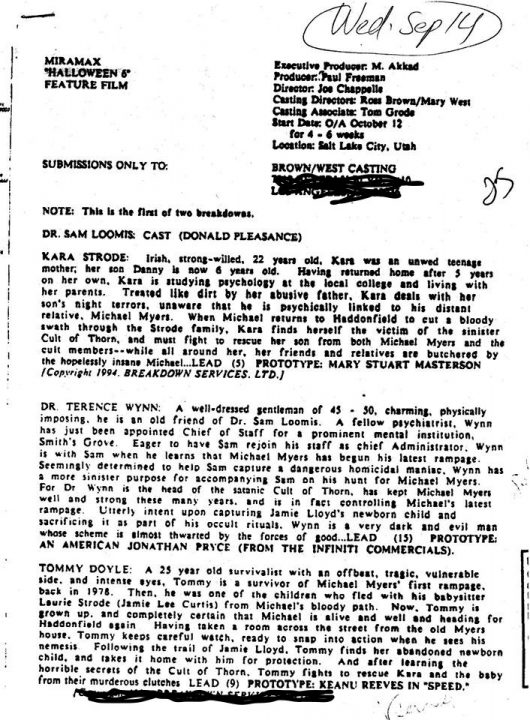
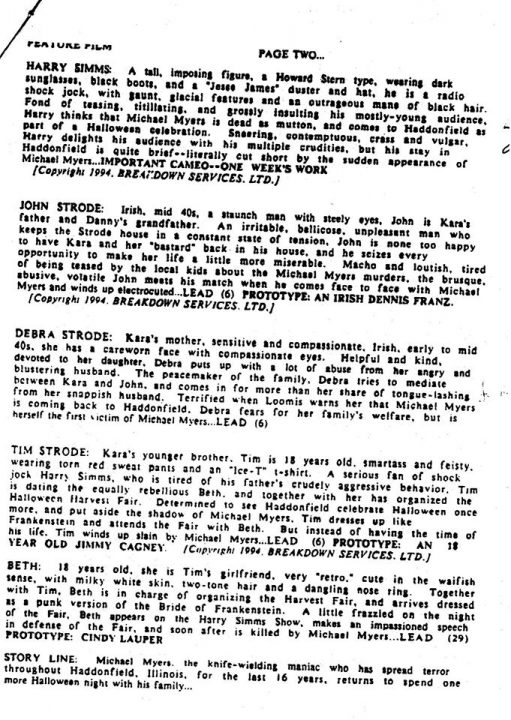
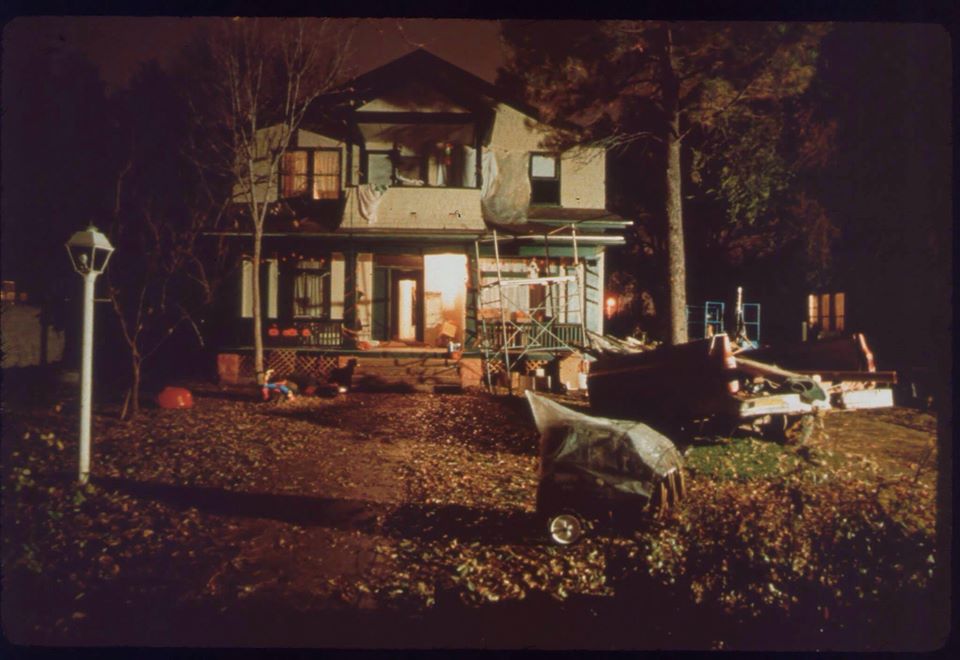
"It's shocking, every bit it doesn't seem that much fourth dimension has passed!" Halloween: The Curse of Michael Myers author Daniel Farrands told united states when he recently saturday down with HalloweenMovies to discuss the movie, his attachment to it, and its legacy on its 25th anniversary.

Released on September 29, 1995, the Trancas International Films, Miramax and Nightfall Productions-produced Halloween: The Curse of Michael Myers continues to engender conversation to this solar day. A direct follow-up to 1989's rather rushed-into-production Halloween 5: The Revenge of Michael Myers (an entry which presented more questions than information technology answered), the sixth film in the Halloween franchise, released by the newly-launched Dimension Films, inarguably polarizes fans to this day.
Perhaps unsurprisingly, the production of Halloween: The Curse of Michael Myers proved a bit of a challenge for all involved, from conception and development through its production and mail service, which included shifting budgets and narrative disagreements, to clandestine reshoots and studio meddling.
But how did Farrands, a horror fan with an undying love of the Halloween film serial, who heralded in part from Santa Rosa, California (a so bucolic town notable to slasher fans for its schoolhouse system'southward famous brushoff of Wes Craven's Scream production), go involved?
As we found, it's a bit of a "small boondocks kid makes proficient" story, and 1 which should prove both inspirational and educational to horror filmmakers eager to follow their dreams, and fascinating to Halloween fans alike.
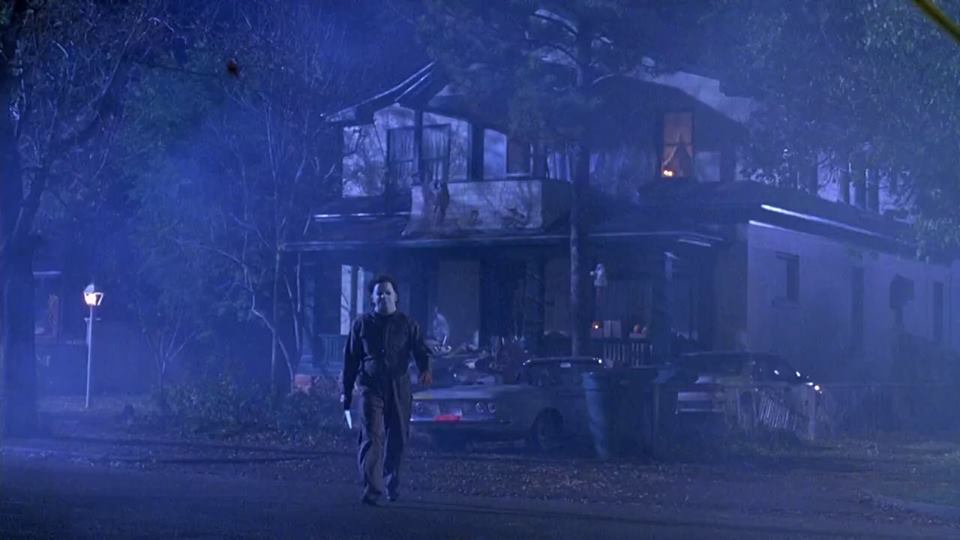
Early Beginnings
"I was raised in a strict, Catholic household," Farrands told united states of his early on childhood in the '80s in the northern California enclave of Santa Rosa, California, "and because of that, horror movies were but taboo, even pre-VHS. But of grade, I found a way to see them. The get-go R-rated horror pic I saw was in 1981, and it was Fri the 13th Function ii, which a neighbour of ours named Kathy Dunn, who was in 12th grade and who was babysitting me, took me, after much cajoling and maybe blackmailing, to a Saturday matinee to see. I was in sixth grade at the time, and to say the least I was terrified!"
"And it all stemmed from the fact that her older brother had these magazines that I'd never seen before: Fangoria," he continued. "Kathy would sneak them out of his room for me to look at, and information technology was like experiencing a Playboy for the get-go time, because I knew they were something I wasn't supposed to see. And I tin still recall vividly the first pic I saw within those pages. It was a still from Fri the 13th Part 2, a shot of Mrs. Voorhees' severed head in the refrigerator, and I looked at it in horror, and then immediately said to Kathy, "Yous have to have me to run across this movie! I'll never tell my mom!"
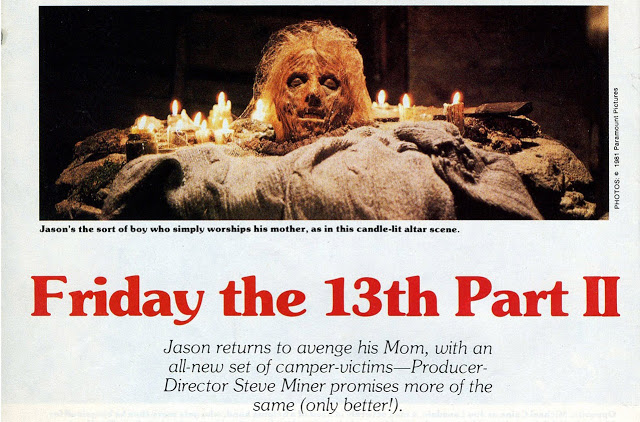
"And so," Farrands chuckled, "because she was kind of a bad babysitter, she took me to run across the film, and that horrified me even more the magazine. I truly felt that I had seen the face of hell, and that I was never going to be the same."
"And and so," he paused, "came Michael."
Every bit Farrands recalls, his outset introduction to the iconic character of Michael Myers occurred afterwards that same year, when John Carpenter's immortal classic Halloween aired, albeit edited, on television equally an NBC "Moving picture of the Week."
Armed with the and then-new engineering science of VHS, Farrands fix out to both watch and to record it.
"We were some of the first families on the block to get a VCR," remembers Farrands of the device, which at the time was duking information technology out with its rival, the Betamax. "So, I considered myself lucky. And I sat in the corner of our couch with a remote command, so that I could record it without the television receiver commercials, which I thought was important, and with the pillows piled loftier around me so that I could peer through them, because I was at once both utterly horrified and exhilarated by the film. And at the end of the ambulation, I had a VHS copy of Halloween! And that was truly the first of my accented obsession with horror, and with the Halloween serial."
"And that obsession grew the very next week," Farrands effused, "when Halloween Two opened in theaters! It was playing at the Coddingtown Mall in Santa Rosa, and there was no style that I wasn't going to meet information technology. I told my mom I'd go on a hunger strike if she didn't have me. So, she did i of those things moms did in the '80s: she dropped me off at the movies. I think that it was a rainy, Saturday afternoon, and that I literally had tears of joy while watching Halloween Two, and also that at that moment I had the epiphany that it was what I needed to do with my life: brand horror movies."
Having already written and directed plays and skits during his elementary school days (roping his friends into the process), besides equally shooting curt films on Super 8 (also starring his school-g chums), the die was cast early for Farrands, whose interest in filmmaking connected to flourish equally he grew, both during his time at Rincon Valley Junior High and and then afterward at Santa Rosa Loftier Schoolhouse.
"I look back on those years fondly," said Farrands, "and my corralling of groups of kids, some of whom probably didn't like me, just to make blood-drenched films in the school's hallways. Which afterward I found ironic, considering when Wes Craven attempted to shoot the original Scream in that location many years later — Santa Rosa High kickoff accustomed the production, but the Santa Rosa Urban center School District Governing Board and then denied information technology. They literally banned the production because of the script's violent content!"
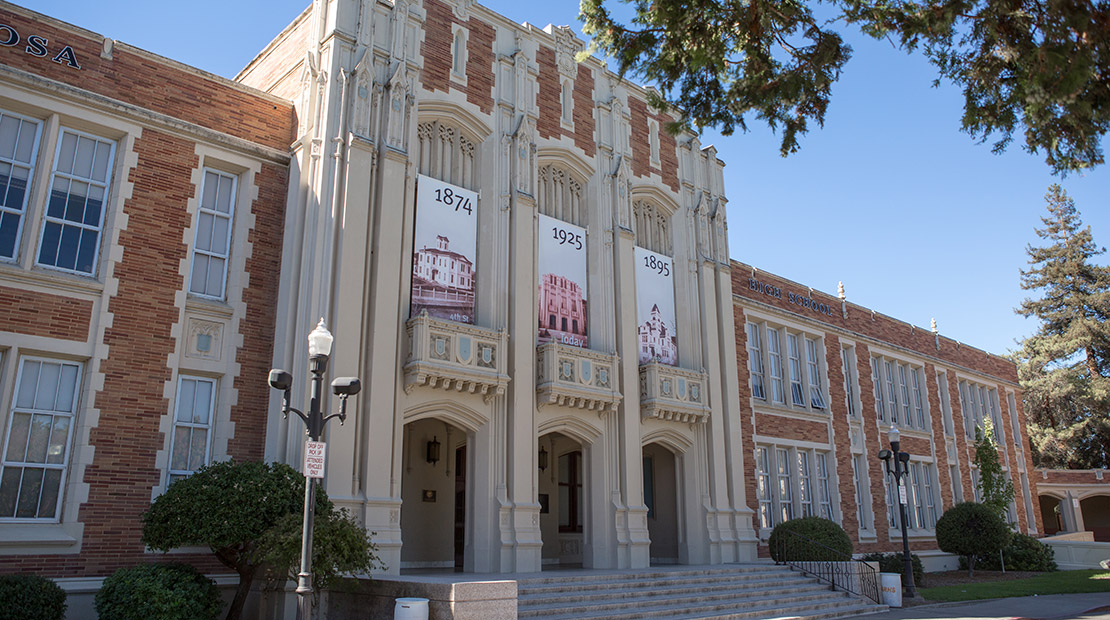
"And every bit that happened right on the heels of Halloween: The Curse of Michael Myers, and equally Dimension Films was behind both films, a Dimension executive – having gotten current of air that I'd gone to Santa Rosa High – asked me to call the school, and to try to talk some sense into them. Merely what was I going to say? The schoolhouse board just didn't care."
"Many years later, when I was shooting the 2011 documentary Scream: The Within Story, I returned to Santa Rosa Loftier School in social club to interview the board members, and I said to them, 'Yous know how interesting information technology is to me that you banned Wes Chicken, a very respected filmmaker, from making a horror pic here, when equally a student I literally dragged headless, claret-gushing human props up and down these hallways while making my own brusque films?'"
"Merely I'grand getting ahead of myself," he continued. "Before whatsoever of that, equally a kid, I merely wanted to make films. And you know, my life every bit a teenager revolved around it."
Catching endless horror films in both wide distribution at local cineplexes and otherwise (the latter at Santa Rosa'due south Park Movie theater, known for screening indie horror flicks i couldn't run across anywhere else) and purchasing the latest issues of Fangoria in downtown Santa Rosa's sketchy "Anarchy Alley" (a backstreet frequented by mohawked punks and '80s counter civilization misfits, who Farrands mused about casting in a moving picture he conceived but never shot humorously called Escape From Santa Rosa), Farrands' path to Hollywood was forming.
"So yeah, to say that John Carpenter's Halloween, and his other films of the time, influenced me, is an understatement," mused Farrands, who like many a young cinephile worked over a summer in a local theater, which immune him to more than efficiently eat '80s fearfulness fare. "I tin can't express enough how absolutely life-changing Carpenter's movies were to me personally. They helped me through hard times and were also personally inspirational. Yous know, every bit a teen, you are thinking about condign an developed and near, 'What will my life be?' And for me, I think the reason that people succeed at things is because they believe they actually didn't take any other choice. And I call up that's kind of what it was for me. I didn't really give myself something else to fall back on. At that place was no other option (than movie)."
Farrands' outset stab at Hollywood (years prior to moving to Tinsel Boondocks, where he'd eventually become part of the Halloween franchise) came at the young age of fourteen, when he boldly decided to personally reach out to the producers of that other slasher franchise, Friday the xiiithursday , in order to tell them exactly what he wanted to run across in the 4th installment.
"I decided that I needed to write the next Friday the xiiith movie," Farrands recalled with a express mirth, after having seen 1982's Office III in 3D, "and I needed to let the producers of that franchise know that I was there for them. So, somehow I found the address of the production office of Frank Mancuso, Jr., who was the producer of those films, and I typed him a letter over Christmas vacation, explaining in peachy detail what Friday the 13th Part 4 should be, and I mailed it off. Well, a few weeks later, I opened my mailbox, and at that place was an envelope in it with a return address that read: Friday iv Incorporated! And I opened information technology, and inside there was a type-written i-page alphabetic character with a signature at the lesser that read 'Frank Mancuso Jr.' And the letter said, 'Fifty-fifty people twenty years your senior exercise non write like this, and I had to pass your letter effectually my office to see if this could be real. This is the start time I've responded to anyone nigh Fri the thirteenth, and I think you lot have talent. I think yous are smart. I think you have passion. And I think that that is the foundation of this industry, then let me be the first to welcome you.'"
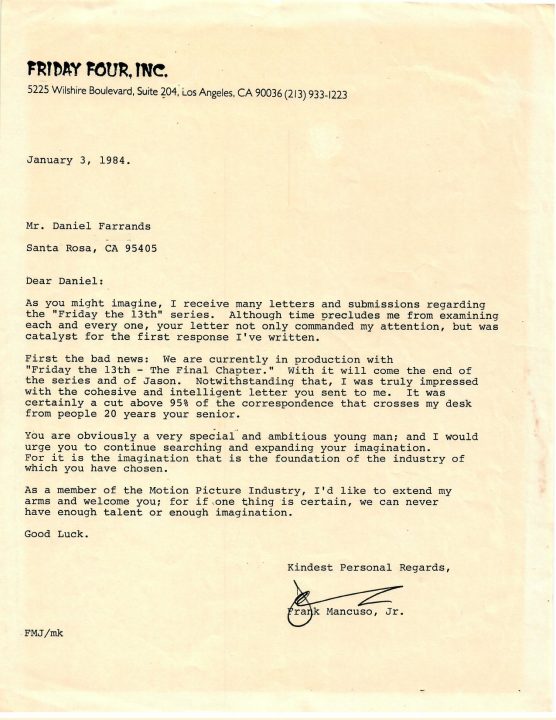
"To this twenty-four hour period, I have that alphabetic character framed in my office," said Farrands, "and information technology will e'er be there, as long as I'one thousand live, considering that for me was the moment when things became tangible. The moment filmmaking became doable. And that I could make it happen."
4 years later, many horror film screenings later and upon graduation from Santa Rosa High School, horror fan Farrands packed up his 1978 Datsun 200SX and fix off for Hollywood, and onto his journey to Halloween: The Curse of Michael Myers.
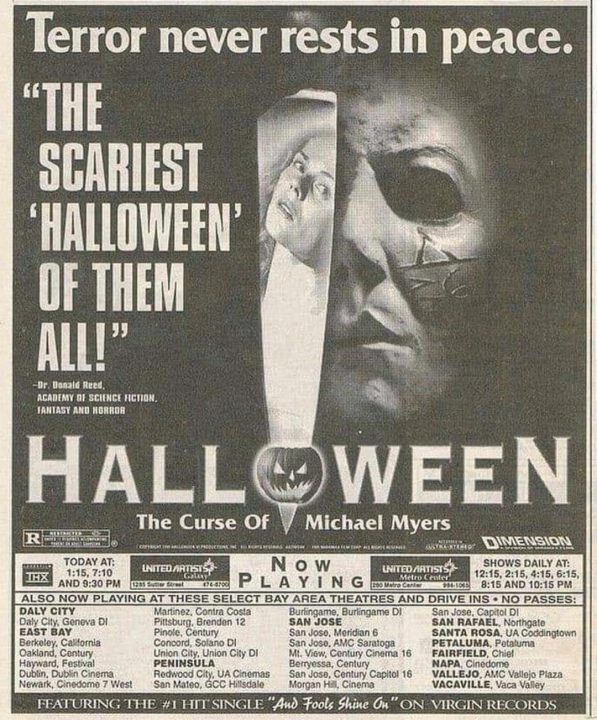
You can observe role two here, in which we talk over his path to Michael Myers, his initial meetings with Halloween serial producer Moustapha Akkad, and his script originally titled Halloween 666.
_
Writer's notation: this interview has been lightly edited and condensed for clarity.
Source: http://halloweenmovies.com/halloween-the-curse-of-michael-myers/
0 Response to "Halloween the Curse of Michael Myers Is Bad and Funny 1990s"
Post a Comment